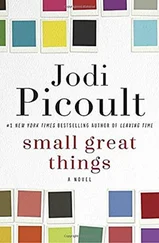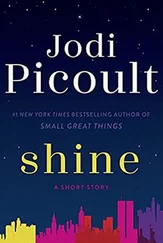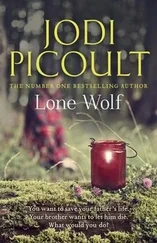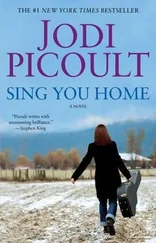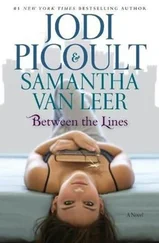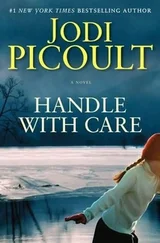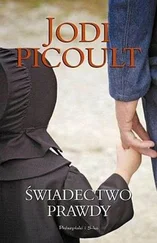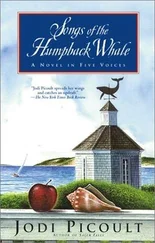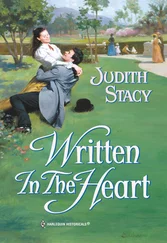My mother set up a course of six jumps for me. I patted Tony’s neck and gathered up my reins for a canter. My mother shouted corrections at me, but I could barely hear her. We flew around the ring so gracefully I wasn’t sure that the horse’s legs were striking the ground. Tony took the first jump long, throwing me back in the saddle. He picked up speed, and I knew that I should be sitting back to slow him, but somehow my body wasn’t doing what I wanted it to. As he landed the next jump, he raced around the corner of the ring. He leaned strangely to one side, and I fell off.
When I opened my eyes, Tony was gnawing on the grass along the edge of the ring and my mother was standing above me. “It happens to everyone,” she said, reaching out her hand to help me up. “What do you think you did wrong?”
I stood and dusted off the britches I’d borrowed from her. “Besides the fact that he was running a hundred miles an hour?”
My mother smiled. “Yeah, it was a little faster than a usual canter,” she said.
I rubbed my hand over the back of my neck and readjusted the black velvet helmet. “He was off center,” I said. “I knew I was going to fall off before it happened.”
My mother pulled Tony back by the reins and held him while I mounted again. “Good girl,” she said. “That’s because when you come across a diagonal, you’ve changed your direction. When you canter, a horse should have the inside lead, right?” I nodded; I remembered this lesson well because it had takup ñ€†en me forever to figure it out: when a horse cantered, or galloped, for that matter, the leg on the innermost side of the ring should be the first to fall; it kept them balanced. “When you change your direction, the horse needs to switch leads. Tony won’t do it naturally-he’s too dumb for that; he’ll just run around off kilter, wearing himself out until he trips or throws you off. You’ve got to tell him, really, that you want him to try a new trick in his repertoire. You break him down to a trot and then pick up the canter again-it’s called a simple change of lead.”
I shook my head. “I can’t remember all this,” I said.
“Yes you can,” my mother insisted. She clucked Tony into a trot. “Do a figure eight,” she said, “and don’t stop. He’s not going to do what you want him to unless you guide him into it. Keep going across your diagonals and do your simple changes.”
By the time we turned down the first diagonal, I had Tony moving quietly toward the middle of the jump. I looked at his hooves, and Tony was on the same lead he’d been on before the jump, only now, because we’d changed direction, it was his outside leg. I pulled back on the reins until he broke his stride, and then I turned his head toward the woods and kicked him into a canter again. “Good,” my mother yelled, and I squeezed Tony over the next line of jumps. I did the same pattern over and over until I thought I was breathing harder than Tony, and I slowed him to a walk without my mother’s command.
I leaned over Tony’s neck, sighing into his coarse mane. I knew about running fast, and knowing you were off balance, and not understanding how to fix yourself. “You don’t see how lucky you have it,” I said. I thought about how easy it would be to take an unfamiliar course if I had someone pushing me in the right direction; a gentle, knowing pressure that let me break down the pace until I was ready to run again.

“When do I get to ride Donegal?” I asked, as we led him to the field where my mother liked to ride him. His mane whipped from left to right as he strained against the leather lead to his halter.
“You could sit him right now,” my mother said, “but you wouldn’t be riding him; he’d be riding you.” She handed me the reins while she adjusted the chin strap of her riding helmet. “He’s a phenomenal horse, he’ll take any jump you put in front of him and automatically change his leads, but he’d just be making you look good. If you’re learning to ride, you should do it on someone like Tony, a workhorse with an attitude.”
I saw my mother swing herself into the saddle and take off at a trot; then I sat down on the grass and watched her ride. I opened the pad I’d brought and took out a stick of charcoal. I tried to draw the spirit that seemed to run straight from my mother’s spine through the flanks and powerful hind legs of Donegal. She didn’t even have to touch the horse; it seemed that she communicated her changes and transitions by willing them into Donegal’s mind.
I drew the crimped jet mane and the arch of the horse’s neck, the steam rising from his sides and the rhythm of his labored breathing. I sketched the rippled muscles of Donegal’s legs, from the line of the blue shin and ankle boots to the raw fo"3"ñ€†rce that throbbed in check beneath the sheen of his haunches. My mother leaned low over his neck, whispering words I could not hear. Her shirt flew out behind her, and she moved faster than light.
When I drew her, she seemed to come right out of the horse, and it was impossible really to tell where he ended and she began. Her thighs were wrapped tight around Donegal’s flanks, and his legs seemed to move across the page. I drew them over and over on the same piece of paper. I was working so furiously that I never noticed my mother getting off Donegal, tying him up to the fence, and coming to sit beside me.
She peered over my shoulder and stared at her image. I had drawn her repeatedly, but the final effect was that of motion: her head and Donegal’s were bent low at several different angles and positions, all rooted to the same flying body. It seemed mythical and sensual. It was as if my mother and Donegal had started off several times but couldn’t decide where they wanted to go.
“You’re amazing,” my mother said, resting her hand on my shoulder.
I shrugged. “I’m okay,” I said. “I could be better.”
My mother touched her fingertips to the edge of the paper. “Can I have it?” she asked, and before I handed it over I peered into the hollows and shadows of the picture, trying to see what else I might have revealed. But this time, in spite of all the secrets that lay between us, there was absolutely nothing.
“Sure,” I said. “Consider it yours.”
Dear Max,
Enclosed is a sketch of one of the horses here. Her name is Aurora, and she looks like the one in your picture book of Snow White, the one you always tried to eat when I read it to you. Oh, I suppose you don’t know-“here” is your grandmother’s place. It’s a farm in North Carolina, and it’s very green and very beautiful. When you are older one day maybe you’ll come down here and learn how to ride.
I think of you quite a lot-I wonder if you are sitting up yet and if you have your bottom teeth. I wonder if you’ll recognize me when you see me. I wish I could explain why I left the way I did, but I am not sure I could put it into words. Just keep believing me when I say I’m coming back.
I don’t know when yet.
I love you.
Do me a favor, will you? Tell your daddy I love him.
Mom
At the end of August I went with my mother to an AHSA “A” list horse show in Culpeper, Virginia. We packed Donegal into the trailer and drove for six hours. I helped my mother lead him into the makeshift stalls under the blue-and-white tent. That night, we paid to practice on the four-foot jumps, which Donegal to eañ€†ok easily after being cooped up for so long. My mother tacked him down and gave him a warm bath. “We’ll see you tomorrow, Don,” she said, “and I’m planning on going home with a champion.”
Читать дальше


